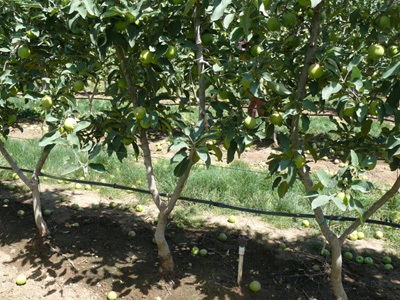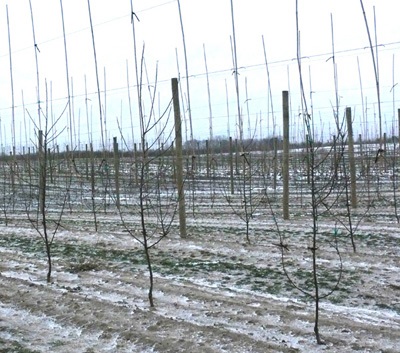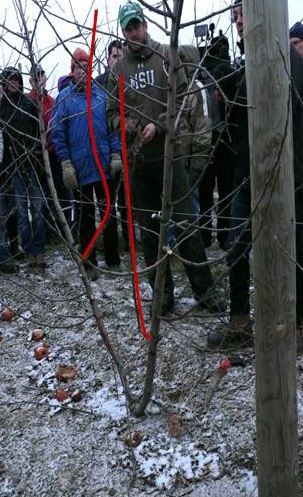Growing multi-leader trees
Learn about multi-leader training for fruit trees and advantages of having multi-leader orchards.
Growing multi-leader trees is gaining interest in North America, especially with two leader trees, also referred to as twin leaders or bibaum. The growing interest in two leaders was evident on the International Fruit Tree Association (IFTA) study tour to Washington State (Figure 1). Alberto Dorigoni, a researcher from Italy, has been pushing further, demonstrating at the Fondazione Edmund Mach research orchard that growing apple trees with more leaders is possible. He has performed trials with up to eight leaders and presented his findings at the IFTA's Annual Conference in Grand Rapids, Michigan.
Why have multiple leaders?
The main goal for training multi-leader trees is to reduce the secondary structure resulting in fruit growing centripetally, closer to the trunk. This will create a wall of fruit which will obtain more uniform light interception through the canopy and produce fruit with more uniform size and colour. With four or more leaders, the vigour is more dispersed among the leaders creating a shorter tree; this creates a pedestrian orchard which could potentially eliminate the use of a ladder or platform, reducing the cost of production. Other advantages of having multi-leader orchards include:
- decreased summer pruning
- mechanical blossom thinning is more feasible
- mechanical pruning is easier
- anti-rain nets (1.1 m wide) are possible with a narrow canopy of four or more leaders
- cost of planting decreases with less trees to plant per hectare
As mechanization increases on the farm, Dorigoni's hypothesis is that it is simpler to adjust the tree to mechanization than it is to adjust mechanization to the tree.
Comparison of number of leaders
When comparing a tall spindle orchard with two leaders, Dorigoni found that there were a greater number of apples that had better colour with two leaders. Within the height of the tree, the distribution of apples and the colour was more uniform. Over the first eight years of production, cumulative yield of two leaders was equal to or slightly less than tall spindle in 'Fuji' apples and lower yielding with 'Gala'. There was an improvement of colour with 'Gala' apples in a two leader system.
In a trial comparing one, two, three, four, six and eight leaders, Dorigoni found that trees are more precocious in the first six years of production with one, two, or three leaders (three leaders being the greatest) than with four, six or eight leaders, quantified in tons/ha. Looking at kg/tree, three and six leaders had the highest yield over the first six years of production. With these results, it would be quick to rule out four or more leaders but yield per hectare can be increased by decreasing row width. Because the vigour is distributed through more leaders, the height is shorter and therefore you can decrease the row width and still obtain optimal light interception.
In another trial comparing two leaders with four leaders, Gala had a higher yield per hectare with two leaders and Fuji had a greater or equal yield per hectare with four leaders.
Training
Two-leaders
- Start with trees that have two buds grafted on each side at the nursery or
- Head off whips from the nursery and train up two side shoots
- Can equalize the vigour between the two leaders by taking the most vigourous leader and make two scores, deep enough to cut into the xylem and phloem, one on each side of the leader, 3–4 inches apart and about 8–12 inches away from trunk
Three-leaders
- Start with a single leader tree, keep the main leader and prune off the feathers except for two that you can train upwards (Figure 2)
- To take out vigour on the central leader, girdle it with a plastic zip tie
Four or more leaders
- With a single leader tree, make a heading cut and take the two side shoot to train up
- Take the lower inside branch off of these two side shoots to make the 3rd and 4th leader (Figure 3)
- Four or more leaders can also be trained similarly like a grapevine as a guyot or double guyot
- Trees need to be angled in nursery
- Bend the leader to grow horizontally
- If training a double guyot, take the lowest branch and bend it to grow horizontally in the opposite direction to the first leader
- Train side branches to grow upright to become leaders
Overall, leaders should be at least 12" apart and optimally 18" apart. Vigour can also be evened out, while the orchard is being established, by cropping the more vigorous leaders to reduce the height.
Are multi-leaders in your future? Multi-leader systems show some great advantages, especially with adaptability to mechanization. Two or three leader systems show the greatest benefit with uniform colour and size of fruit while also maintaining high yields, especially in the early years. If you are considering ways to reduce ladder use and are not interested in investing in a platform, perhaps establishment of a shorter, multi-leader pedestrian orchard may be of interest.
References
- Dorigoni, A., Optimized Training Systems for Fuji, Gala, Honeycrisp. International Fruit Tree Association 2016 Pre-Conference Intensive Workshop. Grand Rapids, Michigan, Feb. 6, 2016.
- Dorigoni, A. Precision Apple Production Systems: Modular, Pedestrian, Fruiting Walls. International Fruit Tree Association 2016 Annual Conference. Grand Rapids, Michigan, Feb. 8-10, 2016.


